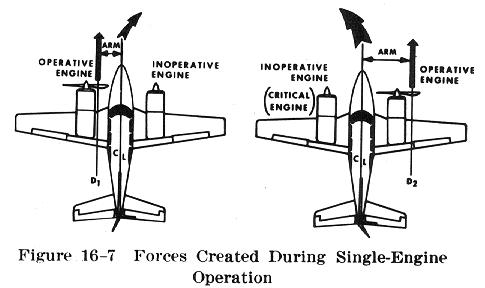
"P-factor" is present in multiengine airplanes just as it is in single engine airplanes. Remember, P-factor is caused by the dissimilar thrust of the rotating propeller blades when in certain flight conditions. It is the result of the downward moving blade having a greater angle of attack than the upward moving blade when the relative wind striking the blades is not aligned with the thrust line (as in a nose high attitude).
In most U.S. designed light twins, both engines rotate to the right (clockwise) when viewed from the rear, and both engines develop an equal amount of thrust. At low airspeed and high power conditions, the downward moving propeller blade of each engine develops more thrust than the upward moving blade. This asymmetric propeller thrust or "P-factor," results in a center of thrust at the right side of each engine as indicated by lines D1 and D2 in Fig. 16-7. The turning (or yawing) force of the right engine is greater than the left engine because the center of thrust (D2)is much farther away from the center line (CL) of the fuselage - it has a longer level arm. Thus, when the right engine is operative and the left engine is inoperative, the turning (or yawing) force is greater than in the opposite situation of a "good" left engine and a "bad" right engine. In other words, directional control may be difficult when the left engine (the critical engine) is suddenly made inoperative.

It should be noted that some light twin engine airplanes are equipped with engines turning in opposite directions; that is, the left engine and propeller turn clockwise and the right engine and propeller turn counterclockwise. With this arrangement, the thrust line of either engine is the same distance from the center line of the fuselage, so there will be no difference in yaw effect between loss of left or right engine.